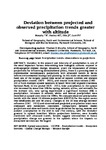Deviation between projected and observed precipitation trends greater with altitude
| dc.contributor.author | Murphy, TR | |
| dc.contributor.author | Furtado Frota, Francisco Gabriel | |
| dc.contributor.author | Ellis, Jonathan | |
| dc.contributor.author | Lunt, Paul | |
| dc.date.accessioned | 2019-11-05T16:54:32Z | |
| dc.date.available | 2019-11-05T16:54:32Z | |
| dc.date.issued | 2019-11-14 | |
| dc.identifier.issn | 0936-577X | |
| dc.identifier.issn | 1616-1572 | |
| dc.identifier.uri | http://hdl.handle.net/10026.1/15122 | |
| dc.description.abstract |
Variation in the amount and intensity of precipitation is one of the most important factors determining how biological systems respond to anthropogenic climate change. Moreover, given the importance of climate projections for influencing (inter)national policy, there is a pressing need to contextualise contemporary projections with observed trends to better informenvironmental strategy and planning. In this study,we examine trends fromone of the longest paired time series of upland (>300 m a.s.l.) and lowland precipitation records (1879-2012), and shorter-term obser - vations (1961-2015) from multiple upland locations in southwestern (SW) England (Dartmoor National Park). In the period 1879-2012, total precipitation at the upland site increased by more than 10% for spring, autumn, winter and annually; at the lowland site, only spring experienced a significant increase (8%) in precipitation. Increases in autumn, winter and annual precipitation were recorded at upland sites since the 1960s.We compare observed precipitation trends with the latest UK climate projections (UKCP18) for the region across 2 timeframes (60 and 90 yr). Changes in the 30 yr average between reference (1981-2010) and observed and projected precipitation totals were compared and deviations calculated. Comparisons between model projections and observed trends show large deviations for spring, summer and autumn precipitation in the mid- to late 21st century, with the deviation greatest in upland localities. However, winter projections were broadly consistent with observed trends. Our results suggest that uncertainties in future precipitation change are greatest in the uplands, where the impacts on ecosystem services are the largest. | |
| dc.format.extent | 77-89 | |
| dc.language | en | |
| dc.language.iso | en | |
| dc.publisher | Inter-Research Science Center | |
| dc.subject | Upland ecosystems | |
| dc.subject | UKCP18 | |
| dc.subject | Precipitation trends | |
| dc.subject | Ecosystem Services | |
| dc.subject | Global change biology | |
| dc.subject | Western Europe | |
| dc.title | Deviation between projected and observed precipitation trends greater with altitude | |
| dc.type | journal-article | |
| dc.type | Journal Article | |
| plymouth.author-url | https://www.webofscience.com/api/gateway?GWVersion=2&SrcApp=PARTNER_APP&SrcAuth=LinksAMR&KeyUT=WOS:000522815700007&DestLinkType=FullRecord&DestApp=ALL_WOS&UsrCustomerID=11bb513d99f797142bcfeffcc58ea008 | |
| plymouth.issue | 1 | |
| plymouth.volume | 79 | |
| plymouth.publication-status | Published | |
| plymouth.journal | Climate Research | |
| dc.identifier.doi | 10.3354/cr01583 | |
| plymouth.organisational-group | /Plymouth | |
| plymouth.organisational-group | /Plymouth/Faculty of Science and Engineering | |
| plymouth.organisational-group | /Plymouth/Faculty of Science and Engineering/School of Biological and Marine Sciences | |
| plymouth.organisational-group | /Plymouth/Faculty of Science and Engineering/School of Geography, Earth and Environmental Sciences | |
| plymouth.organisational-group | /Plymouth/REF 2021 Researchers by UoA | |
| plymouth.organisational-group | /Plymouth/REF 2021 Researchers by UoA/UoA06 Agriculture, Veterinary and Food Science | |
| plymouth.organisational-group | /Plymouth/REF 2021 Researchers by UoA/UoA14 Geography and Environmental Studies | |
| plymouth.organisational-group | /Plymouth/Users by role | |
| plymouth.organisational-group | /Plymouth/Users by role/Academics | |
| dcterms.dateAccepted | 2019-09-30 | |
| dc.rights.embargodate | 2020-11-13 | |
| dc.identifier.eissn | 1616-1572 | |
| dc.rights.embargoperiod | Not known | |
| rioxxterms.versionofrecord | 10.3354/cr01583 | |
| rioxxterms.licenseref.uri | http://www.rioxx.net/licenses/all-rights-reserved | |
| rioxxterms.type | Journal Article/Review |


